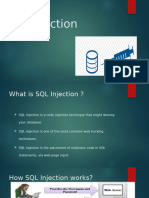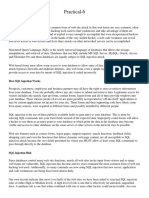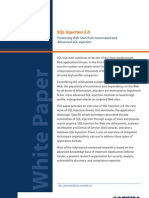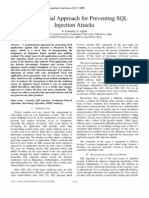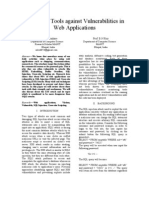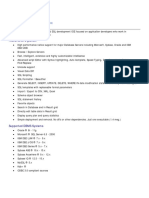Sub: Web Security Name: Shubham Sati ROLL NO: 17BCA1100 Class: Bca5C
Sub: Web Security Name: Shubham Sati ROLL NO: 17BCA1100 Class: Bca5C
Uploaded by
Shubham SatiCopyright:
Available Formats
Sub: Web Security Name: Shubham Sati ROLL NO: 17BCA1100 Class: Bca5C
Sub: Web Security Name: Shubham Sati ROLL NO: 17BCA1100 Class: Bca5C
Uploaded by
Shubham SatiOriginal Description:
Original Title
Copyright
Available Formats
Share this document
Did you find this document useful?
Is this content inappropriate?
Copyright:
Available Formats
Sub: Web Security Name: Shubham Sati ROLL NO: 17BCA1100 Class: Bca5C
Sub: Web Security Name: Shubham Sati ROLL NO: 17BCA1100 Class: Bca5C
Uploaded by
Shubham SatiCopyright:
Available Formats
SUB: WEB SECURITY
NAME: SHUBHAM SATI
ROLL NO: 17BCA1100
CLASS: BCA5C
1.What is SQL Injections ?
Ans. SQL Injection is a type of an injection attack that
makes it possible to execute malicious SQL statements.
These statements control a database server behind a web
application. Attackers can use SQL Injection vulnerabilities
to bypass application security measures. They can go
around authentication and authorisation of a web page or
web application and retrieve the content of the entire SQL
database. They can also use SQL Injection to add, modify,
and delete records in the database.
SQL injection usually occurs when you ask a user for input,
like their username/userid, and instead of a name/id, the
user gives you an SQL statement that you
will unknowingly run on your database.
There are a wide variety of SQL injection vulnerabilities,
attacks, and techniques, which arise in different situations.
Some common SQL injection examples include:
• Retrieving hidden data, where you can modify an SQL
query to return additional results.
• Subverting application logic, where you can change a
query to interfere with the application's logic.
• UNION attacks, where you can retrieve data from
different database tables.
• Examining the database, where you can extract
information about the version and structure of the
database.
• Blind SQL injection, where the results of a query you
control are not returned in the application's responses.
example: Consider a shopping application that displays
products in different categories. When the user clicks on
the Gifts category, their browser requests the URL:
https://insecure-website.com/products?category=Gifts
This causes the application to make an SQL query to
retrieve details of the relevant products from the database:
SELECT * FROM products WHERE category = 'Gifts' AND
released = 1
This SQL query asks the database to return:
• all details (*)
• from the products table
• where the category is Gifts
• and released is 1.
2. Explain how users can Find SQL Injection
Bugs.
Ans: SQL Injection Examples and ways to prevent SQL
Injection Attacks on Web Applications:
While testing a website or a system, the tester's aim is to
ensure if that tested product is as much protected, as
possible.
Security testing is usually performed for this purpose. In
order to perform this type of testing, initially, we need to
consider, which attacks are most likely to happen. SQL
Injection is one of those attacks.
SQL Injection is considered as one of the most common
attacks as it can bring serious and harmful consequences
to your system and sensitive data.
The only sure way to prevent SQL Injection attacks is input
validation and parametrised queries including prepared
statements. The application code should never use the
input directly. The developer must sanitise all input, not only
web form inputs such as login forms. They must remove
potential malicious code elements such as single quotes. It
is also a good idea to turn off the visibility of database
errors on your production sites. Database errors can be
used with SQL Injection to gain information about your
database.
If you discover an SQL Injection vulnerability, for example
using an Acuteness scan, you may be unable to fix it
immediately. For example, the vulnerability may be in open
source code. In such cases, you can use a web application
firewall to sanitize your input temporarily.
3. How user can Find and prevent XPath
InjectionFlaws? Explain
ans: The XPath Injection Security Scan tries to attack the web
service by replacing the TestStep's original parameters with
malicious strings, designed to expose potential flaws in web
services that are using user input in XPath expressions. By using
assertions, you can assure that the attack didn't expose sensitive
data, return a session ID, etc.
How to prevent it :
• The user input needs to be sanitized such
as quote(‘) can be replaced with “'”. The validation
has to be added both in client and server side.
• We can use parametrized queries (like Prepared
Statements in SQL) in which queries are precompiled
and user input is passed as parameters rather than
expressions.
"//users[LoginID/text()= $LoginID and passwd/text()=
$password]"
• Proper error pages have to used that do not disclose
any information in the time of an error that could benefit
the attacker.
Disclaimer: The information published in this article is only
for educational purposes. The content of this article is
based on my personal learning and experience. Any misuse
of information will not be responsibility of the author.
4. What do you mean by the SQL injection
attack and also discuss the types of SQL
injection attack ?
Ans : Structured Query Language is a language designed to
manipulate and manage data in a database. Since its
inception, SQL has steadily found its way into many
commercial and open source databases. SQL injection is
a type of cybersecurity attack that targets these databases,
using specifically crafted SQL statements to trick the
systems into doing unexpected and undesired things.
Unsanitised Input
Unsanitised input is a common type of SQLi attack in which
the attacker provides user input that isn’t properly sanitized
for characters that should be escaped, and/or the input
isn’t validated to be the type that is correct/expected.
For example, a website used to pay bills online might
request the user’s account number in a web form and then
send that to the database to pull up the associated account
information. If the web application is building a SQL query
string dynamically with the account number the user
provided, it might look something like this:
“SELECT * FROM customers WHERE account = ‘“ +
userProvidedAccountNumber +”’;”
While this works for users who are properly entering their
account number, it leaves the door open for attackers.
Blind SQL Injection
Also referred to as Inferential SQL Injection, a Blind SQL
injection attack doesn’t reveal data directly from the database
being targeted. Rather, the attacker closely examines indirect clues
in behavior. Details within HTTP responses, blank web pages for
certain user input, and how long it takes the database to respond to
certain user input are all things that can be clues depending on the
goal of the attacker. They could also point to another SQLi attack
avenue for the attacker to try.
Out-of-Band Injection
This is a type of Out-of-Band Injection attack. In this case, the
attacker will provide an SQL injection that will get stored and
executed by a separate behavior of the database system. When the
secondary system behavior occurs (it could be something like a
time-based job or something triggered by other typical admin or
user use of the database) and the attacker’s SQL injection is
executed, that’s when the “reach out” to a system the attacker
controls happens.
You might also like
- SQL InjectionDocument22 pagesSQL InjectionNabeel Muhammed NNo ratings yet
- SQL InjectionDocument4 pagesSQL InjectionAbdulkerimNo ratings yet
- ST Vincent's Guild-Acolyte's Handbook 3Document59 pagesST Vincent's Guild-Acolyte's Handbook 3Anderson Guisolphi100% (1)
- Networks Security SQL InjectionDocument19 pagesNetworks Security SQL Injectionmohammad zidanNo ratings yet
- Manual SQL InjectionDocument14 pagesManual SQL InjectionDigital WorldNo ratings yet
- Mini Project On Information and Cyber Security: SQL (Structured Query Language) InjectionDocument9 pagesMini Project On Information and Cyber Security: SQL (Structured Query Language) Injectioncyan whiteNo ratings yet
- SQL Injection Cheat SheetDocument6 pagesSQL Injection Cheat SheetqabiswajitNo ratings yet
- CH 5Document20 pagesCH 5nimona2024hirkoNo ratings yet
- Interview Preparation Part-1Document53 pagesInterview Preparation Part-1Abdul Mateen UkkundNo ratings yet
- Framework of SQL Injection Attack: IJASCSE Vol 1 Issue 1 2012Document12 pagesFramework of SQL Injection Attack: IJASCSE Vol 1 Issue 1 2012IJASCSENo ratings yet
- Survey of SQL Injection AttacksDocument6 pagesSurvey of SQL Injection AttacksArslan AmanNo ratings yet
- CS - SQL Injection Attack (Discussion-2)Document3 pagesCS - SQL Injection Attack (Discussion-2)khushiyadav88400No ratings yet
- SQL Injection DocumentationDocument8 pagesSQL Injection Documentationahmed.nistas2001No ratings yet
- SQL Injection Is A Type of Injection Attack That Occurs WhenDocument3 pagesSQL Injection Is A Type of Injection Attack That Occurs WhenWajihaa IqbalNo ratings yet
- SQL InjectionDocument14 pagesSQL Injectionmahendra.siemNo ratings yet
- SQL Injection: What Is It?Document8 pagesSQL Injection: What Is It?Shabari GirishNo ratings yet
- SQL Injection - WikipediaDocument72 pagesSQL Injection - WikipediaVaibhav MajgaonkarNo ratings yet
- Abstract: Most of The Companies Nowadays Uses Websites To Run Their Operations As Well As StoreDocument7 pagesAbstract: Most of The Companies Nowadays Uses Websites To Run Their Operations As Well As StoreJohnson SneijderNo ratings yet
- Practical-6: SQL Injection OverviewDocument6 pagesPractical-6: SQL Injection OverviewAkash KataraNo ratings yet
- SQL InjectionDocument16 pagesSQL InjectionAmmar MousaNo ratings yet
- WP SQL Injection 20Document11 pagesWP SQL Injection 20Abdul Basit ZulkefliNo ratings yet
- SQL Injection GuideDocument9 pagesSQL Injection Guiderobparent38No ratings yet
- SQL InjectionDocument22 pagesSQL InjectionRNo ratings yet
- Security Controls and Measures For SQL Injection Attack (TASK 4)Document10 pagesSecurity Controls and Measures For SQL Injection Attack (TASK 4)Sairam .ANo ratings yet
- Ethics - Lect6 - SQL InjectionDocument19 pagesEthics - Lect6 - SQL Injectionomarnader16No ratings yet
- Injection Attacks SQL InjectionDocument6 pagesInjection Attacks SQL InjectionAkshat PattiwarNo ratings yet
- SQL Injection CyberSecurityDocument26 pagesSQL Injection CyberSecurityAlex Jésus Moreira AriasNo ratings yet
- Task 12Document5 pagesTask 12Sridhar PNo ratings yet
- A Comprehensive Guide to SQL Injection Prevention 1 6Document7 pagesA Comprehensive Guide to SQL Injection Prevention 1 6H.M.Haseeb AnsariNo ratings yet
- SQL Injection Cheat SheetDocument1 pageSQL Injection Cheat Sheetagape82No ratings yet
- Guru99 Security TestingDocument9 pagesGuru99 Security TestingqabiswajitNo ratings yet
- SQL Injection AttackDocument9 pagesSQL Injection AttackanohaNo ratings yet
- Web SecurityDocument64 pagesWeb Securitykapilkushwah7599No ratings yet
- SQL InjectionDocument3 pagesSQL Injectiondanieldamalie9No ratings yet
- SQL Injection Detection and Prevention Techniques: University Technology MalaysiaDocument8 pagesSQL Injection Detection and Prevention Techniques: University Technology MalaysiaPramono PramonoNo ratings yet
- Literature Review On SQL InjectionDocument8 pagesLiterature Review On SQL Injectionbsdavcvkg100% (1)
- SQL InjectionDocument12 pagesSQL InjectionMelchor GaerlanNo ratings yet
- Web Security - Injection AttacksDocument3 pagesWeb Security - Injection AttackssandaruNo ratings yet
- Assignment MS 681Document12 pagesAssignment MS 681shuvo.csteNo ratings yet
- A Taxonomy of SQL Injection AttacksDocument5 pagesA Taxonomy of SQL Injection AttacksJay ShrotriyaNo ratings yet
- Unit 5 SQL InjectionDocument4 pagesUnit 5 SQL InjectionYashNo ratings yet
- SQL InjectionDocument2 pagesSQL InjectionR x41x4aNo ratings yet
- SQL InjectionDocument9 pagesSQL InjectionJovelyn Dela RosaNo ratings yet
- Chameli Devi Group of Institutions, Indore: CS-503 (C) Cyber Security Unit - VDocument10 pagesChameli Devi Group of Institutions, Indore: CS-503 (C) Cyber Security Unit - Vsignup onsitesNo ratings yet
- SQLiDocument20 pagesSQLisumanxlataNo ratings yet
- Quick Guide To SQL Injection Attacks and Defenses - EnglishDocument31 pagesQuick Guide To SQL Injection Attacks and Defenses - Englishsavafut007No ratings yet
- SQL Injection Attacks and Prevention Tec PDFDocument4 pagesSQL Injection Attacks and Prevention Tec PDFPramono PramonoNo ratings yet
- Prevention of SQL Injection Attacks by Using Service Oriented Authentication TechniqueDocument5 pagesPrevention of SQL Injection Attacks by Using Service Oriented Authentication TechniqueKarthik SNo ratings yet
- Breaking Down The 5 Most Common SQL Injection ThreatsDocument27 pagesBreaking Down The 5 Most Common SQL Injection Threatskashif majeed janjuaNo ratings yet
- What Is A SQL Injection?Document6 pagesWhat Is A SQL Injection?Sridhar PNo ratings yet
- SQL InjectionDocument1 pageSQL Injectioncauchi13No ratings yet
- Review Vijitha Presentation2Document14 pagesReview Vijitha Presentation2vt vuyyuruNo ratings yet
- Rial Approach For Preventing SQLDocument6 pagesRial Approach For Preventing SQLShaik NooruddinNo ratings yet
- Reveiw of Tools Against Vulnerabilies in Web ApplicationsDocument4 pagesReveiw of Tools Against Vulnerabilies in Web ApplicationsNilesh KunhareNo ratings yet
- Preventing SQL Injection Vulnerabilities Developers GuideDocument12 pagesPreventing SQL Injection Vulnerabilities Developers Guidemashrabi324No ratings yet
- Code InjectionDocument11 pagesCode InjectionJitendra RaiNo ratings yet
- Reference 1 - 2017Document13 pagesReference 1 - 2017abenezer ketemaNo ratings yet
- SQL Injection Monitoring Security Vulnerabilities in Web ApplicationsDocument6 pagesSQL Injection Monitoring Security Vulnerabilities in Web ApplicationsInternational Journal of Application or Innovation in Engineering & ManagementNo ratings yet
- Detection and Prevention of SQL-Injection Attacks of Web Application Using Comparing Length of SQL QueryDocument4 pagesDetection and Prevention of SQL-Injection Attacks of Web Application Using Comparing Length of SQL QueryKarthik SNo ratings yet
- Hacking : The Ultimate Comprehensive Step-By-Step Guide to the Basics of Ethical HackingFrom EverandHacking : The Ultimate Comprehensive Step-By-Step Guide to the Basics of Ethical HackingRating: 5 out of 5 stars5/5 (5)
- Zabbix Manual v1.6Document259 pagesZabbix Manual v1.6Rodney MachadoNo ratings yet
- SQL DBXDocument57 pagesSQL DBXFor GameNo ratings yet
- Ramakrishna Semaladhari - ChatGPT Prompt Maestro - Unleashing The Power of AI Communication-Self (2023)Document160 pagesRamakrishna Semaladhari - ChatGPT Prompt Maestro - Unleashing The Power of AI Communication-Self (2023)romopambudi197075100% (1)
- Mixture Solid To SolidDocument15 pagesMixture Solid To SolidKenneth Charles Martinez80% (15)
- Lecture-1 & 2: Professor Dept. of EEE, GMRIT-RajamDocument25 pagesLecture-1 & 2: Professor Dept. of EEE, GMRIT-Rajampramana_gmritNo ratings yet
- 05.4-Boq-Pek. Mep. ElektikalDocument3 pages05.4-Boq-Pek. Mep. ElektikalTrefastoreNo ratings yet
- PED 10 PRELIM MODULE Developmental Reading 1Document12 pagesPED 10 PRELIM MODULE Developmental Reading 1Marjorie Gumate BaracolNo ratings yet
- 9917-Article Text-42194-2-10-20221106Document11 pages9917-Article Text-42194-2-10-20221106Annisa SyafaNo ratings yet
- Electrolysis HLDocument34 pagesElectrolysis HLRyan BoukaaNo ratings yet
- National Institute of Technology: M. Tech. Degree IN Non - Destructive TestingDocument34 pagesNational Institute of Technology: M. Tech. Degree IN Non - Destructive TestingPrasadNo ratings yet
- Unit 6 - Grammar - VocabularyDocument9 pagesUnit 6 - Grammar - Vocabularytoannv8187No ratings yet
- Stretching TherapyDocument95 pagesStretching TherapySpineCare Physiotherapy100% (4)
- Data Analyst Courses On CourseraDocument3 pagesData Analyst Courses On CourseraNithyapriya VeeraraghavanNo ratings yet
- Expression of QuantityDocument8 pagesExpression of QuantityGIYAN DWINo ratings yet
- Heat Transfer: Energy EntropyDocument10 pagesHeat Transfer: Energy EntropyKeybee AcquiatNo ratings yet
- Ink and PaintDocument19 pagesInk and Paintclasum69No ratings yet
- A Presentation On Symmetrical FaultsDocument20 pagesA Presentation On Symmetrical FaultsJacobNo ratings yet
- 305 Heart Health Lesson PlanDocument10 pages305 Heart Health Lesson Planapi-508745379No ratings yet
- Representation and Organization of Knowledge in MemoryDocument44 pagesRepresentation and Organization of Knowledge in MemoryBrylle Deeiah100% (1)
- 7-Unit4 Work, Energy, and PowerDocument17 pages7-Unit4 Work, Energy, and Powerelty TanNo ratings yet
- Lent and Easter - A Journey of Hope: Doctrinal FocusDocument15 pagesLent and Easter - A Journey of Hope: Doctrinal FocusFazonelaMigsNo ratings yet
- MRT Corp MRT3 CMC ENDocument1 pageMRT Corp MRT3 CMC ENRAZIF CIVICZZNo ratings yet
- Balaji Vandavasi Rev-0 (2) - Model PDFDocument1 pageBalaji Vandavasi Rev-0 (2) - Model PDFepe civil1No ratings yet
- Design and Development of Fruit WasherDocument11 pagesDesign and Development of Fruit WasherRafael SantosNo ratings yet
- 2023-03-16 Audit Report - StreamSwapv1.1Document21 pages2023-03-16 Audit Report - StreamSwapv1.1abhishek kumarNo ratings yet
- Modul 8 - Metamorphic RocksDocument52 pagesModul 8 - Metamorphic RocksEldeNo ratings yet
- Term Paper Gender InequalityDocument4 pagesTerm Paper Gender Inequalityc5td1cmc100% (1)
- 5th LPDocument8 pages5th LPMaribel LunesaNo ratings yet
- Singing The StoryDocument7 pagesSinging The StoryDs TeronNo ratings yet














